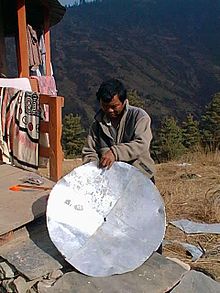Mahabir Pun
Mahabir Pun (born February 22, 1955 in Myagdi , Nepal ) is a Nepalese teacher, activist and entrepreneur. He was inducted into the Internet Hall of Fame in 2014.
life and work
Pun attended a village school in his native Nangi, Myagdi District, with no paper, pencils or qualified books. Traditionally, the locals had no education and most of the men joined the British Gurkha Army. His family moved to the southern plains of Nepal and invested all of their savings in his education. After graduating from high school, he worked as a teacher at four schools for about 12 years and at the same time supported the education of his siblings. In 1989, after numerous applications to British and US universities, he received a partial scholarship at the University of Nebraska in Kearney (Nebraska) . In 1996 he graduated with a bachelor's degree in natural sciences and returned to his home village of Nangi. He recognized the critical need for sustainable education and founded a secondary school that served as a model for local educational and economic development. This Himanchal High School placed a special emphasis on computer education. In order to generate money for running the school and creating job opportunities for the villagers, he started several projects in his village and the surrounding villages, such as yak and rabbit farm, cheese and jam production, a campsite and many others. Since there were no telephones or modern communication systems in this region, he had to walk from one village to the next for several hours to communicate with the people. He returned to the University of Nebraska for a Masters Degree in Educational Administration in 2001. While in the United States, he had realized that information technology could transform the education system and economy of his village, and he had taken courses to acquire the skills necessary to assemble, renovate, and use computers required are. On his return to Nepal he successfully campaigned for the donation of used computers from Japan, Malaysia, Australia, Singapore and the USA. He gave computer courses to students and fellow teachers, but it proved impossible to establish a telephone connection to the nearest city and the Internet. So he sent an email to the British Broadcasting Corporation announcing his dilemma. In 2001 donors and volunteers helped him establish a wireless connection between Nangi and the neighboring village of Ramche by using small handcrafted tree-mounted television antennas. Further donations soon led to the construction of improvised mountain stations and a connection to Pokhara. In 2002, he founded the Nepal Wireless Networking Project to use radio technology to build a local communication network and connect people in the Himalayan communities. His goal was to bring the Internet to rural schools, promote digital literacy and improve the quality of education. In 2003, Nangi had a wireless connection to the Internet. He later distributed used computers donated from abroad to other schools in other villages and began developing a wireless distance learning project. His distance learning and online education services were the first attempt to use technology to address the shortage of qualified teachers in Nepal. By 2006, 13 mountain villages were connected to a Wi-Fi network and the Internet. Since then, he has expanded the network and services to over 175 remote villages in 15 districts of Nepal. Today these villages use the internet for e-learning, e-healthcare, local e-commerce, community discussions, money transfers and weather monitoring. He has received numerous national and international awards and recognitions.
Honors (selection)
- 2002: Ashoka Fellow, Ashoka Foundation
- 2004: Overall Social Innovations Award, Global Ideas Bank, UK
- 2007: Ramon Magsaysay Prize , Ramon Magsaysay Foundation of the Philippines
- 2007: Honorary Doctorate from the University of Nebraska , USA
- 2014: Jonathan B. Postel Service Award , Internet Society
- 2014: Induction into the Internet Hall of Fame
Web links
- biography
- Mahabi Pun, own biography
- Mahabir Pun, who brought wireless internet in Nepal's remote villages
- Networking Nepal: the Mahabir Pun story
- ICT for rural community development: Interview with Mahabir Pun (2009)
- Travel report in zeitonline: Mahabir, the stuffy philanthropist
| personal data | |
|---|---|
| SURNAME | Pun, Mahabir |
| ALTERNATIVE NAMES | महाबीर पुन (Nepali) |
| BRIEF DESCRIPTION | Nepalese teacher, activist and entrepreneur |
| DATE OF BIRTH | February 22, 1955 |
| PLACE OF BIRTH | Myagdi , Nepal |

